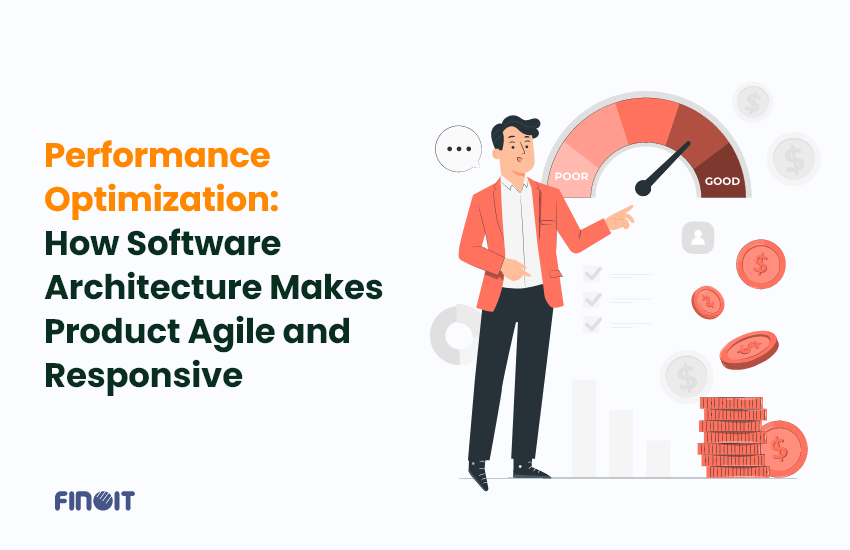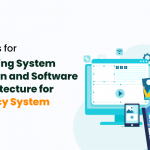Performance Optimization: How Software Architecture Makes Product Agile and Responsive

We live in a very dynamic time, where we expect to get everything at the snap of our fingers. Users want applications to deliver groceries in minutes and complete money transfers in seconds. This clearly implies that speed and responsiveness are core to the success of any application. Whether you are launching an app, website, or any digital platform, seamless experiences, swift responses, and near-instantaneous access to information or services have become a non-negotiable aspect of user satisfaction and retention.
So, what lies at the core of achieving these expectations? What determines the performance capabilities of a product? The answer is system architecture, which acts not merely as a technical foundation but also as an invisible machinery that orchestrates how quickly your product responds to user inputs, delivers content, processes data, and adapts to varying workloads.
How Choice of Software Architecture Influences Product Performance?
Every interaction a user has with a product has two vital steps:
- User submits the query
- Action is performed to deliver the desired outcome
However, between these two steps is a series of complex software development processes. From handling data requests to executing computations, the product architecture dictates how efficiently these tasks are carried out.
Therefore, the choice of software architecture influences your product’s ability to scale, its capacity to handle increased user loads without compromising speed, and its overall responsiveness to your end-user actions. Furthermore, with a well-designed architecture, you can optimize resource utilization, minimize latency in your application, and ensure that your product functions smoothly even during peak usage hours.
The following part of the article will provide insight into how a modern system architecture influences your product performance and responsiveness to provide your customer with an enhanced user experience (UX). Let’s begin!
How Does Software Architecture Pattern Influences Product Speed?
Improving the speed of your product interface is an effective way to set it apart from competitors. Speed is something that can be easily measured and compared, making it an important factor to consider when updating your application. By hiring a solution architect to improve your system’s architecture, you can see if the time it takes to resolve user queries has been reduced. If the delivery time is quicker, you can deploy the updated system and provide a better product to your users.
Following are the critical factors within your system architecture that significantly influence your product’s speed:
Processing Power:
The deployment of your hardware and software components can significantly impact the speed of data processing, calculations, and other computational tasks, which in turn can affect the overall efficiency of your system. By utilizing powerful processors and well-optimized algorithms, you can significantly enhance the speed and efficiency of your system.
It’s important to carefully consider the specific requirements of your system and select appropriate hardware and software components that can meet those requirements, while also providing sufficient room for future scalability and upgrades.
Additionally, implementing effective monitoring and optimization techniques can help maintain the performance of your system at peak levels. By taking these factors into account and making informed decisions, you can significantly improve the overall performance of your system, resulting in faster and more efficient operations.
Memory Management:
Efficient memory utilization is critical. How your system manages memory, including caching strategies, data storage structures, and memory access patterns, profoundly affects speed. With proper memory management, you can ensure that your resources are efficiently allocated to avoid unnecessary memory fragmentation, which can slow down your product.
Optimizing the memory of your product’s system architecture guarantees that the available memory has been used optimally. Hence, your application will have a reduced likelihood of slowdowns due to memory shortages or inefficient memory use. Increased overhead, which is also a common factor that slows down your system, can also be resolved with effective memory management. If your system architecture utilizes proper memory management tactics, it can successfully utilize the cache memory which is faster than your main memory.
Maximizing its memory utilization will increase the speed of your product like, in systems where physical memory (RAM) is insufficient, the operating system resorts to swapping data between RAM and secondary storage (paging). Swapping operations are typically slower and if you can reduce them, you can improve your product speed as well. Moreover, with higher memory management in your system architecture, your application will facilitate quicker access to data or retrieve it when required.
Network Capabilities:
Network infrastructure and its efficiency ensure seamless performance of your application in a reduced time. The better your architecture is designed, the faster your system will be prepared to handle network requests efficiently. The system design can further minimize latency through optimized communication protocols and leverage content delivery networks (CDNs) or edge computing to improve the speed of data transmission and accessibility significantly.
An efficient design further considers network topology, routing algorithms, load balancers, and caching mechanisms to ensure the application can handle high traffic volumes while maintaining low latency and consistent performance.
Parallelism and Concurrency:
Using parallel processing and concurrency within a system’s architecture enables your system to execute multiple tasks simultaneously. This results in a reduced timeline for the entire customer journey. This is achieved through the implementation of various techniques, such as:
1. Multi-threading – It allows a single process framework to execute multiple threads of execution concurrently, thereby improving system responsiveness.
2. Asynchronous programming – It enables tasks to be executed without blocking the main thread, which can improve the overall user experience.
3. Distributed computing – It involves the use of multiple networked computers working together to execute a task, which can significantly increase the processing power available to the system.
These techniques work in concert to enable systems to handle complex tasks efficiently and provide a seamless user experience in a shorter time frame.
Optimized Database Design:
The method used to store, index, and retrieve the data significantly impacts the performance of data retrieval and manipulation. Effective indexing strategies, optimized database schemas, and well-tuned queries are some of the key components that can expedite data retrieval and manipulation, thereby improving the overall performance of the database system.
Creating a system that analyzes data access patterns and selects appropriate indexing techniques can help reduce the time taken to fetch data from a database. In addition, proper database schema design and optimization can minimize data duplication, reduce storage space, and improve the efficiency of data retrieval. Lastly, fine-tuning queries by optimizing the execution plan, selecting appropriate join algorithms, and minimizing disk I/O can significantly enhance the performance of your application system.
How Does System Architecture Impacts Product Responsiveness?
If your system’s architecture is unsuitable, it can significantly limit your product’s responsiveness. For instance, if you’re using SQL for storing your data, it may not be able to handle 50 million requests per second if the only way to access the necessary information is through a query. Similarly, if you’re storing data in S3, querying that data by anything other than its key can be quite slow. This is because you have to load up each file and scan it programmatically. Querying the storage based on the attributes of your data can result in a trade-off between execution speed and cost. However, there might still be a way to improve your system’s performance by storing the attributes of your data elsewhere in conjunction with the key.
This scenario highlights the impact of system architecture in improving your product responsiveness. Architectural elements listed below play a crucial role in determining and enhancing responsiveness, such as:
Latency Reduction:
To minimize latency, architects and developers can make various choices when designing the system’s architecture. For example, they can optimize the code to execute faster, reduce network round-trip times, or use advanced techniques like edge computing that involves processing data at the edge of the network, closer to the user, instead of relying solely on centralized data centers. By doing so, the data doesn’t have to travel as far, which can significantly reduce latency and improve the system’s overall responsiveness.
Minimizing latency is crucial for providing a seamless and responsive experience to users. By making informed architecture choices and employing innovative techniques like edge computing, architects and developers can ensure that users have a smooth and satisfying experience, regardless of their location or the device they are using.
Cacheing Strategies:
The performance and responsiveness of your system, widely depend on Caching techniques. It denotes frequently accessed data or computations at different layers of the architecture. By storing data in a cache, which is a fast-access memory, closer to the processing unit, you can retrieve data faster than from slower storage disks or databases.
To make your system even more responsive, you can place the cache at different layers of the architecture, such as the application layer, the web server layer, or the database layer. Each layer has its own benefits and drawbacks, and the choice of where to place the cache depends on the specific requirements of your system.
By caching commonly used data, your system can swiftly respond to requests without retrieving or recalculating the same information repeatedly from slower storage, thus significantly reducing response times. This technique can also help reduce the load on your system’s resources, as it reduces the number of requests that need to be processed by the system.
Load Balancing:
Efficient load balancing is crucial for you to manage system resources and make it more responsive effectively. It works by distributing incoming requests evenly across all available resources, such as servers or CPUs, to ensure that no component becomes overwhelmed or overloaded. This approach helps you maintain optimal utilization of resources, allowing your system to operate efficiently and effectively.
Load balancing further helps you to ensure that the response times of your application system remain consistent, even during high-traffic periods. By distributing the workload, your system can avoid bottlenecks and optimize available resources, leading to better performance and improved user experience.
Efficient load balancing is particularly important for systems that experience varying workloads. For example, suppose your product has a seasonal demand surge. In that case, it helps you ensure that your system remains responsive and can handle the fluctuating demand without significantly impacting performance.
Asynchronous Processing:
Asynchronous processing architectures, such as event-driven or message-based systems, provide a valuable solution for your application that require high responsiveness. These architectures enable software systems to continue processing other tasks while waiting for certain operations to complete. By doing so, they prevent potential bottlenecks and ensure that the system remains responsive to other user requests concurrently.
Event-driven systems, for example, use event notifications to trigger specific actions, which helps to reduce latency and improve efficiency. On the other hand, message-based systems use messages to communicate between different components of the system, which helps to decouple the components and make the system more scalable. However, it is important to note that these architectures require careful design and implementation to ensure that they are effective and reliable.
Scalability and Resource Allocation:
When designing the architecture, it is essential to ensure that the system has the flexibility to scale automatically based on demand. Dynamic scaling facilitates the allocation of resources based on the current user traffic, ensuring that the system can efficiently handle the load.
Moreover, a well-designed architecture also supports fault tolerance, redundancy, and load balancing. Fault tolerance allows the system to continue operating even when one or more components fail. Redundancy ensures that the system has backup components in place to take over if a component fails. Load balancing helps distribute the load evenly across the system, preventing any one component from becoming overloaded.
Real-Time Data Processing:
Architectures that support real-time processing, automation, and analytics are designed to handle large amounts of data in real time, allowing for immediate actions based on incoming data. These architectures typically use distributed computing and data processing techniques to ensure high availability and fault tolerance. In addition, they often incorporate machine learning algorithms to provide real-time insights and predictions.
In financial systems, for example, real-time processing and analytics can help you quickly identify and respond to market trends, reducing risks and improving returns. In IoT devices, they can be used to monitor and control devices in real-time, enabling automated responses to changing conditions. In live interactive platforms, real-time processing and analytics can be used to personalize content and make real-time user recommendations.
Software designs that support real-time processing and analytics are a critical component of modern data-driven applications, enabling you to quickly respond to changing conditions and take advantage of opportunities in real-time.
Conclusion:
To ensure your project runs smoothly and is successful, it’s important to choose the right architecture pattern. Different patterns are suited for different applications, so understanding which one to use is key. Implementing these strategies we discussed can improve the responsiveness and speed of your system, leading to a better user experience.
In your journey to execute custom software development and optimize the performance of your product, we can help you achieve heights you have imagined. Get in touch with us to know how we can augment your product lifecycle.


